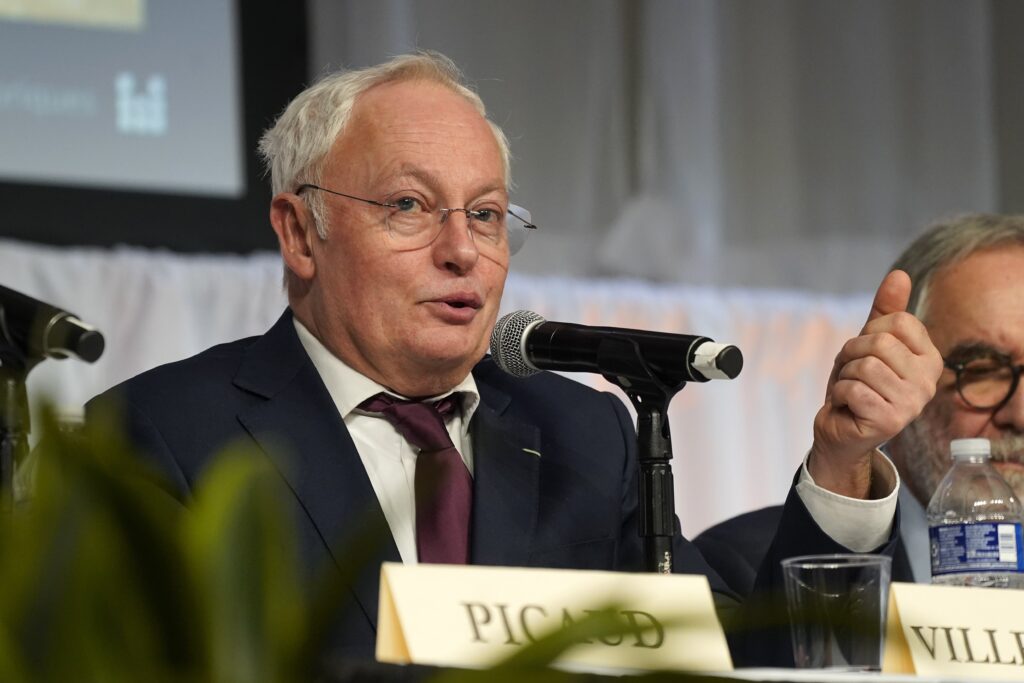
The annual New York Encounter opened on Valentine’s Day evening with a love letter to Notre Dame Cathedral, presented by its restoration architect, Philippe Villeneuve.
The three-day event (February 14-16) at the Metropolitan Pavilion on East 18th Street in Manhattan featured lectures, performances, and exhibits on Catholic themes and topics, along with a children’s village and other activities.
Maurizio Maniscalco, president and co-founder of the New York Encounter, introduced the event and welcomed the 1,300 people in attendance, which began with a performance by recording artist Vaneese Thomas. Maniscalco then introduced Cardinal Seán O’Malley, Archbishop Emeritus of Boston.
Cardinal O’Malley joked that while he had no personal experience with firefighting, “for 200 years, the Capuchin Friars were the firemen in Paris.” He said that the fire that burned Notre Dame, while sad, was emblematic of the Church, quoting T.S. Eliot: “The Church must be forever building, and always decaying, and always being restored,” which also served as the title for the evening’s presentation. He then introduced Villeneuve, who was joined on stage by Michel Picaud, president of the nonprofit Friends of Notre Dame de Paris, and Maniscalco.
Villeneuve quickly came to the forefront of calls to rebuild and restore Notre Dame Cathedral in Paris after it caught fire and burned on April 15, 2019. As Architect in Chief for Historic Monuments, Villeneuve had already worked on restorations of other cathedrals in France, along with numerous castles and chateaus.
Speaking mostly in English with some difficulty, sometimes slipping into French, and aided by occasional translation, Villeneuve detailed the scope of the work that was to be done on Notre Dame following the fire, recognizing that while it was a tragedy, it was also an unprecedented opportunity for restoration, an opportunity that should be seized.
Notre Dame suffered from the fire in at least two ways, he explained: first, by burn and fire damage inflicted by the original blaze, and also from the harm caused by the thousands of gallons of water used to extinguish it.
The first steps of the reconstruction were to shore up weak areas, remove debris, and prevent further damage, along with creating a temporary covering of the cathedral’s knave. He described the necessity of removing all of the stained glass for cleaning and preservation. Villeneuve pointed out the need to minimize the potential for injury early in the reconstruction. “I didn’t want to let anyone work under the vault of the knave, so we just had a crew work behind the knave. But we had to carry all of the stones and the wood out of the cathedral, so we used robots,” he said.
The work also faced unique architectural challenges. For example, rebuilding the cathedral’s spire required scaffolding weighing 600 tons, needing its own temporary support. Also, the statues around the cathedral’s spire had, over time, turned from their original bronze color to the green patina familiar to New Yorkers on the Statue of Liberty.
In addition to addressing fire and water damage, the cathedral had been affected by centuries of dirt, soot, and lead pollution.
Throughout his presentation, Villeneuve showed before and after photos, from the early days when the knave was filled with charred wood and debris, to years later when the same object, area, or feature had been brought back to life.
He emphasized the need for sustainability throughout the project, especially for the use of wood. “You can see the new technology; it’s the same technology of the Middle Ages,” Villeneuve said, to laughter. “We have used the same material because we knew that it had eight or more centuries, that it had never been restored, only with a little repair. So why use another material?” Any trees used in the reconstruction were replanted afterward, he said.
Following the main presentation, Maniscalco asked Villeneuve if he felt intimated by the task that he faced. “I am completely, as you can see, crazy. No, more seriously, I loved this cathedral since I was a little, little kid, from when I was five years old,” he said. Villeneuve described how he went there as a child to hear musical performances and that to him, “architecture is music.” “I think that from my birth to now, it was written that I had to do what I did.”
“I said that I was like Joan of Arc. I was completely determined. I saw my cathedral burning. For me, it was the evidence that I had to rebuild this cathedral,” Villeneuve said.


